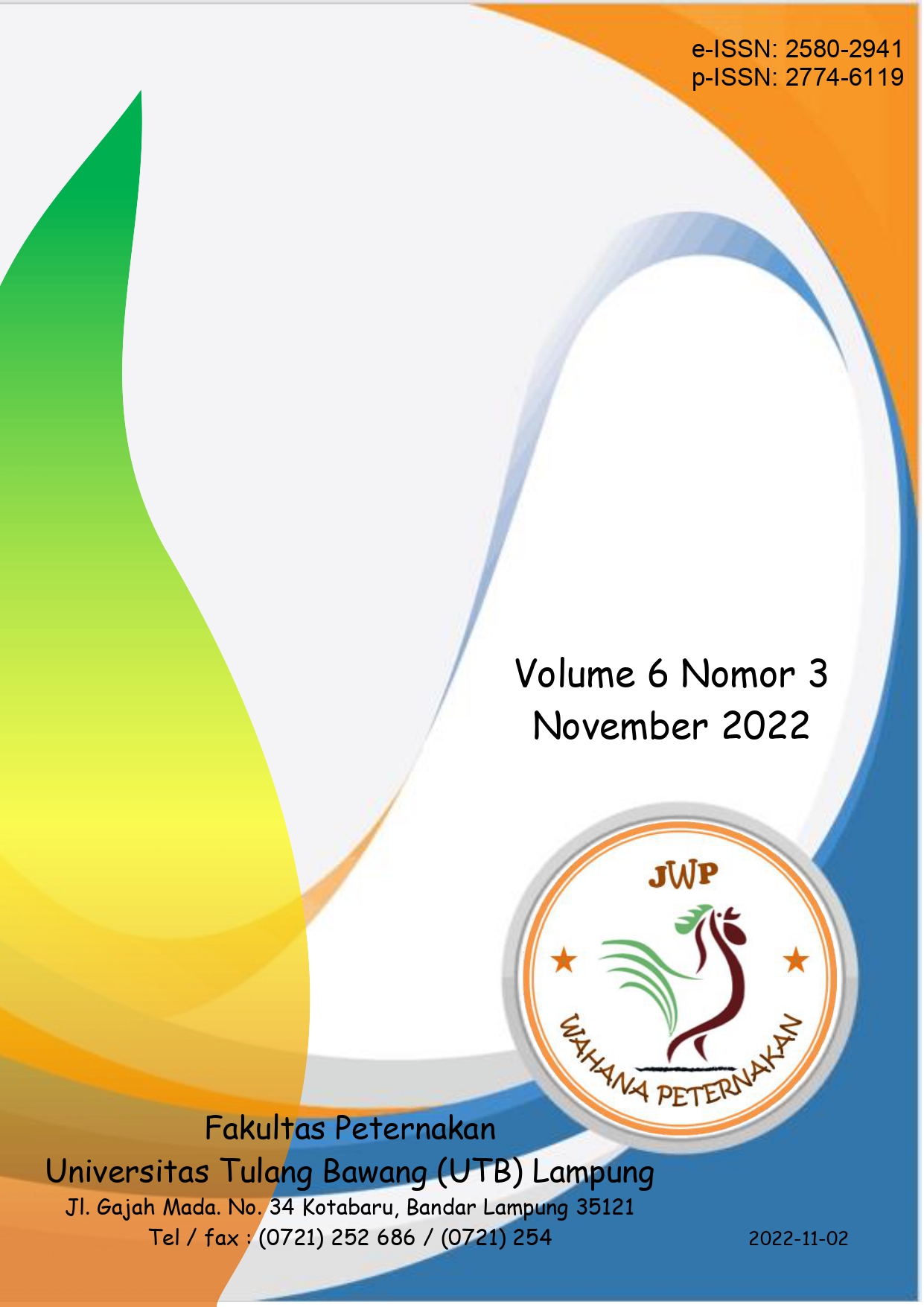PENGARUH RASIO NASI DAN DAGING TERHADAP TOTAL ASAM, PH, DAN SIFAT ORGANOLEPTIK BEKASAM DAGING SAPI
DOI:
https://doi.org/10.37090/jwputb.v6i3.693Abstract
This study aimed to know the effect of rice and meat ratio on the total acid, pH, and organoleptic properties of beef bekasam. The study employed 5 treatments with 4 replications, namely, 30% rice and 70% meat (P1), 40% rice and 60% meat (P2), 50% rice and 50% meat (P2). P3), 60% rice and 40% meat (P4), 70% rice and 30% meat (P5). The variables observed were cooking loss, pH, total acid, moisture content and organoleptic properties. The data were analysed for variance (ANOVA) and post hoc DMNRT. The results showed that the ratio of rice and meat had a significant effect (P<0.05) on cooking loss, pH, total acid and organoleptic properties of beef bekasam, but had no significant effect (P>0.05) on moisture content. So it could be concluded that the ratio of rice and meat in the manufacture of beef bekasam had an effect on cooking loss, pH and total acid but has no effect on the water content of beef bekasam. The use of a ratio of 30% rice and 70% meat showed the bekasam with the best physical characteristics and the most prefered by panelists.
Keywords: Bekasam, organoleptics, pH, total acids.
Downloads
References
Ahmed, S., K.C. Dora, S. Sarkar, S. Chowdhury, dan S. Ganguly. 2013. Quality analysis of shidal: A traditional fermented fish product of Assam, North-East India. Indian Journal of Fishery, 60(1): 117-123.
Anihouvi, V. B., J.M. Kindossi, dan J.D. Hounhouigan. 2012. Processing and quality characteristics of some major fermented fish products from Africa: a critical review. International Research Journal of Biological Sciences, 1(7): 72-84.
AOAC. 2005. Association Official Analitycal Chemistry. Official method of analysis of AOAC International. (18th ed). AOAC, Maryland.
Arfianty, B.N., S. Farisi, dan E.C. Nugroho. 2017. Dinamika populasi bakteri dan total asam pada fermentasi bekasam ikan patin (pangasius hypopthalmus). Jurnal Biologi Eksperimen dan Keanekaragaman Hayati. 4 (2): 43-49.
Desniar, R. Iman, S. Antonius dan R.M. Nisa. 2012. Senyawa antimikroba yang dihasikan bakteri asam laktat asal bekasam. Jurnal Akuantika. 3(2): 135-145.
Hadiyanti, M.R dan P.R, Wikandari. 2013. Pengaruh konsentrasi dan penambahan bakteri asam laktat Lactobacillus plantarum B1765 sebagai kultur starter terhadap mutu produk bekasam bandeng (chanos chanos). Journal of Chemistry. 2(3): 136-143.
Haq, A.N., D. Septinova dan P.E. Santosa. 2015. Kualitas fisik daging dari pasar tradisional di Bandar Lampung. Jurnal Ilmiah Peternakan Terpadu. 3(3): 98-103.
Kalista, A., A. Supriadi, S.H. Rachmawati J. 2012. Bekasam ikan lele dumbo (Clarias gariepinus) dengan penggunaan sumber karbohidrat yang berbeda. Jurnal FishtecH. 1(1): 102-110.
Mumtianah, O. N., E. Kusdiyantini, dan A. Budiharjo. 2014. Isolasi, Karakterisasi Bakteri Asam Laktat, dan Analisis Proksimat dari Makanan Fermentasi Bekasam Ikan Mujair (Oreochromis mossambicus Peters). Jurnal Akademika Biologi, 3(2): 20-30.
Nuraini, A., M. Ibrahim dan L. Rianingsih. 2014. Pengaruh penambahan konsentrasisumber karbohidrat dari nasi dan gula merah yang berbeda terhadap mutu bekasam ikan nila merah (oreochromis niloticus). Jurnal Saintek Perikanan, 10(1): 19-25.
Nurwantoro, V.P. Bintoro, A.M. Legowo, A. Purnomoadi., L.D. Ambara, A. Prokoso dan S. Mulyani. 2012. Nilai pH, kadar air dan total Escherichia coli daging sapi yang dimarinasi dalam jus bawang putih. Jurnal Aplikasi Teknologi Pangan, 1(2): 20-22.
Omega, 2016. Pengaruh Media Fermentasi dan Konsentrasi Garam Terhadap Kualitas Bekasam Ikan Gabus (Channa striata). Skripsi. Program Studi Teknologi Hasil Pertanian, Fakultas Pertanian Universitas Muhammadiyah Sidoarjo, Sidoarjo.
Petronika, A. 2017. Pengaruh Jenis Sumber Karbohidrat Terhadap pH, Total Asam Tertitrasi dan Mutu Bekasam Ikan Patin (Pangasius Djambal). Skripsi. Program Studi Biologi, Jurusan Pendidikan Matematika dan Ilmu Pengetahuan Alam, Fakultas Keguruan dan Ilmu Keguruan, Universitas Sanata Dharma, Yogyakarta.
Melia, S., E. Purwati, Y.F. Kurnia, & D.R. Pratama. 2019. Antimicrobial potential of Pediococcus acidilactici from Bekasam, fermentation of sepat rawa fish (Tricopodus trichopterus) from Banyuasin, South Sumatra, Indonesia. Biodiversitas Journal of Biological Diversity, 20 (12): 3532-3538.
Rinto. 2018. Manfaat Fungsional Produk Fermentasi Perikanan Indonesia. Universitas Sriwijaya, Palembang.
Sari, I.N., Dahlia dan D. Octavian. 2013. Quality charateristics fermented tilapia (Oreochromis niloticus) different carbohydrate source. Jurnal Perikanan dan Kelautan. 8(2): 80.
Savadkoohi S., H. Hoogenkamp, K. Shamsi, A. Farahnaky. 2014. Color, sensory and textural attributes of beef frankfurter, beef ham and meat-free sausage containing tomato pomace. Meat Sci. 97(4): 410-418.
Soeparno. 2005. Ilmu dan Teknologi Daging. Gadjah Mada University Press, Yogyakarta.
Suharyanto. 2019. Penuntun Praktikum Dasar Teknologi Hasil Ternak. Uji Kualitas Fisik Daging Segar. Jurusan Peternakan Fakultas Pertanian Universitas Bengkulu, Bengkulu.
Suyatno, N.I Sari, dan S. Leokman. 2015. Pengaruh lama fermentasi terhadap mutu bekasam ikan gabus (channa striata). Jurnal Perikanan dan Ilmu Kelautan 3(2).
Usmiati, S. 2010. Pengawetan Daging Segar dan Olahan. Balai Besar Penelitihan dan Pengembangan Pascapanen Pertanian. Kampus Penelitihan Pertanian, Bogor.
Wikandari, P.R., Suparmono, Y. Marsono, dan S.R Endang. 2011. Potensi bekasam bandeng (chanos chanos) sebagai sumber angiotensin i coverting enzyme inhibitor. Biota. 16(1): 145-152.
Downloads
Published
Issue
Section
License
Copyright (c) 2022 Gita Lispi Marlena, Urip Santoso, Suharyanto suharyanto

This work is licensed under a Creative Commons Attribution-ShareAlike 4.0 International License.








